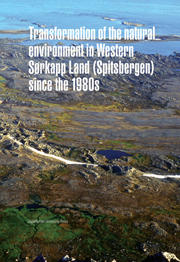Book contents
- Frontmatter
- Contents
- Introduction
- Study area
- Methods and materials
- Components of natural environment
- Environmental and landscape changes
- Climate warming
- Glacial recession
- Transformation of landforms and Quaternary deposits
- Changes of water drainage and networks
- Changes in vegetation
- Conclusions and prognosis for environmental change
- References
- List of enclosures (maps)
- Plate-section
Climate warming
from Environmental and landscape changes
Published online by Cambridge University Press: 05 September 2014
- Frontmatter
- Contents
- Introduction
- Study area
- Methods and materials
- Components of natural environment
- Environmental and landscape changes
- Climate warming
- Glacial recession
- Transformation of landforms and Quaternary deposits
- Changes of water drainage and networks
- Changes in vegetation
- Conclusions and prognosis for environmental change
- References
- List of enclosures (maps)
- Plate-section
Summary
Changes in the climate in western Sørkapp Land mirror global climate fluctuations. This is especially true of the northern hemisphere and Spitsbergen. There is a lack of meteorological data to show continuous climate fluctuations for the entire Sørkapp Land peninsula. Indeed, basic meteorological observations (mainly temperature) were carried out in different places throughout the peninsula but for very short periods of time, mostly in the summer (Ziaja 1999). Continuous meteorological observations have been carried out at the Polish Polar Station, which belongs to the Institute of Geophysics of the Polish Academy of Sciences, on Isbjørnhamna bay (Marsz, Styszyńska 2007). The bay is located along the northern coast of Hornsund Fjord, only 10 km from the study area. Hence, the station's data may be considered representative of western Sørkapp Land.
The Little Ice Age ended with a very cold period in the 1890s in Spitsbergen, including Sørkapp Land. A relatively warm contemporary period “after the Little Ice Age” began in the early 20th century. Secondary cold and warm climate fluctuations occurred during the 20th and early 21st century. The most recent fluctuations, starting in the 1980s, appear to point to a significant warming trend (Brázdil 1988; Ziaja 2004). This is certainly true of the western island's coast, both north and south of Hornsund Fjord.
- Type
- Chapter
- Information
- Transformation of the Natural Environment in Western Sorkapp Land (Spitsbergen) since the 1980s , pp. 49 - 50Publisher: Jagiellonian University PressPrint publication year: 2011



